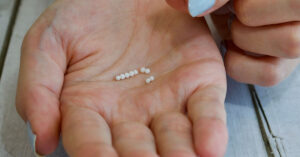 Hormone pellet therapy has gained popularity in recent years as a solution for managing hormonal imbalances. Whether it’s menopause, andropause, or other conditions that lead to fluctuating hormone levels, hormone pellets promise a steady, natural hormone release to restore balance. However, with growing popularity comes the spread of misinformation, leaving many wondering about their safety. Are hormone pellets a good choice for you, or are the risks too great to consider?
Hormone pellet therapy has gained popularity in recent years as a solution for managing hormonal imbalances. Whether it’s menopause, andropause, or other conditions that lead to fluctuating hormone levels, hormone pellets promise a steady, natural hormone release to restore balance. However, with growing popularity comes the spread of misinformation, leaving many wondering about their safety. Are hormone pellets a good choice for you, or are the risks too great to consider?
In this article, we will talk about common myths about hormone pellet therapy and separate them from the facts.
What Are Hormone Pellets?
Hormone pellets are small, rice-sized implants that contain bioidentical hormones, such as estrogen and testosterone. They are inserted under the skin, typically in the hip or buttocks area, where they gradually release hormones over time.
The purpose of hormone pellets is to restore the body’s hormonal balance by providing a steady release, much like the natural rhythms of hormone production in the body.
Hormone pellets are commonly used by both men and women. For women, they help address hormonal deficiencies caused by menopause, while men use testosterone pellets to combat low testosterone levels (a condition known as andropause).
This form of hormone replacement therapy (HRT) is designed to reduce the ups and downs of other methods, such as oral pills or patches, offering a more consistent hormone delivery.
Common Myths About Hormone Pellets
Myth 1: Hormone Pellets Are Dangerous
One of the most widespread myths about hormone pellets is that they’re dangerous. This misconception likely stems from the general concerns people have about hormone therapy.
However, hormone pellets are FDA-approved when prescribed and monitored by a qualified healthcare provider, making them a safe treatment option. They are only dangerous if not used properly, which is why it’s essential to consult a trained professional.
Individualized dosing plays a significant role in the safety of hormone pellet therapy. With a healthcare provider’s careful monitoring, dosing is tailored to your unique needs, ensuring that you receive just the right amount of hormones for optimal health.
Myth 2: Hormone Pellets Cause Hormone Overload
Another myth is that hormone pellets release too much hormone, leading to an overload. This concern can be troubling, especially for those new to hormone therapy. However, hormone pellets are designed to release hormones gradually over a period of months, mimicking the body’s natural hormone production.
Instead of flooding the body with excessive hormones, hormone pellets provide a steady, consistent dose that keeps hormone levels balanced. This controlled release reduces the likelihood of hormone spikes, a common issue with other hormone replacement methods.
Myth 3: Hormone Pellet Therapy is Unnatural
Some people are hesitant to try hormone pellet therapy because they believe it’s unnatural. This is mainly due to confusion around the term “bioidentical hormones.” Bioidentical hormones are designed to be structurally identical to the hormones naturally produced by the human body. This makes them a more natural option than synthetic hormones, which are often used in other forms of hormone therapy.
Bioidentical hormones in hormone pellets can help restore your hormonal balance in a way that mirrors your body’s natural processes. Therefore, hormone pellet therapy is as natural as possible, using the body’s own blueprint to regulate hormone levels.
Myth 4: Hormone Pellets Are Only for Women
While it’s true that hormone pellets are often associated with women undergoing menopause, this therapy is not limited to women. Men also benefit from hormone pellet therapy, especially those with low testosterone levels.
Testosterone pellets are used to treat symptoms like fatigue, low libido, and decreased muscle mass. These symptoms, which often affect men as they age, can be addressed with hormone pellet therapy, providing a safe and effective solution for both genders.
Myth 5: Hormone Pellets Are Permanent
Many people mistakenly believe that once hormone pellets are inserted, they can’t be adjusted or removed. In reality, hormone pellets are not permanent. They dissolve naturally over time, and if needed, future pellet doses can be adjusted to meet a person’s changing needs.
If a patient decides they no longer wish to continue hormone therapy, they can simply stop receiving the pellets. This flexibility makes hormone pellet therapy a non-committal and adaptable treatment option.
Facts About Hormone Pellet Therapy
Fact 1: Consistent Hormone Delivery
Hormone pellets provide a consistent, steady dose of hormones over several months. This method reduces the fluctuations in hormone levels that often occur with other HRT methods like pills, patches, or creams. The gradual release of hormones ensures that patients experience fewer highs and lows, leading to more stable moods and energy levels.
Fact 2: Minimal Maintenance Required
One of the main advantages of hormone pellet therapy is its low maintenance. Once the pellets are inserted, there’s no need for daily applications or constant monitoring. This convenience is a huge draw for people who struggle with remembering to take pills or apply patches.
Fact 3: Personalized Treatment
Hormone pellet therapy is not a one-size-fits-all approach. The therapy is highly personalized, with dosing based on each individual’s hormone levels, symptoms, and health goals. Through blood tests and regular consultations, healthcare providers ensure that the treatment is tailored specifically to meet the patient’s needs, ensuring the best possible results.
Fact 4: Proven Benefits
Studies show that hormone pellet therapy can lead to significant improvements in various aspects of health, including energy levels, mood, bone density, and libido. With proper administration, patients report feeling more balanced, with fewer symptoms of hormonal imbalances.
Fact 5: Safe When Administered by Professionals

When hormone pellet therapy is administered by a qualified healthcare provider, it’s a safe and effective treatment. It’s important to consult a trained expert who can properly insert the pellets and monitor the patient’s progress over time. This ensures that any potential issues can be addressed quickly and that the treatment remains safe and effective.
Potential Risks and How to Manage Them
While hormone pellet therapy is generally safe, there are some risks associated with it. These include:
- Risk 1: Infection at the Insertion Site: Though rare, infections can occur at the site where the pellet is inserted. Proper hygiene during the procedure and aftercare can minimize the risk of infection.
- Risk 2: Difficulty Adjusting Hormone Levels: Since the pellets are inserted under the skin and dissolve over time, they can’t be immediately adjusted. It’s important to work closely with your healthcare provider to find the right dose and monitor any changes in symptoms.
- Risk 3: Side Effects from Hormonal Imbalances: If the pellets are not dosed correctly, there may be side effects like acne, mood changes, or hair thinning. Regular check-ins with your healthcare provider help ensure the right hormone balance.
Who Should Avoid Hormone Pellet Therapy?
Hormone pellet therapy isn’t suitable for everyone. Individuals who are pregnant or planning to conceive, as well as those with a history of hormone-sensitive cancers, should avoid hormone pellets. A thorough health evaluation is necessary before starting any hormone replacement therapy to ensure it’s safe and appropriate for the patient’s unique health profile.
Tips for Safe Hormone Pellet Therapy
To ensure the safest and most effective hormone pellet therapy, consider the following tips:
- Choose a qualified, experienced healthcare provider who specializes in hormone therapy.
- Regularly monitor your hormone levels through blood tests to ensure your doses remain optimal.
- Communicate openly with your healthcare provider about any side effects or changes in symptoms.
Conclusion
Hormone pellet therapy is a safe and effective treatment for those struggling with hormonal imbalances when administered by a qualified professional. By dispelling the myths surrounding hormone pellets and focusing on the facts, it becomes clear that this therapy offers numerous benefits, including consistent hormone delivery and minimal maintenance. If you’re considering hormone pellet therapy, consult your healthcare provider to determine if it’s the right option for your individual needs.

